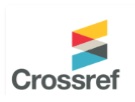Human Body Tracking Method Based on YOLOV5s Object Detection
DOI:
https://doi.org/10.24237/ASJ.01.04.692CKeywords:
Body Tracking, Human Action Detection, YOLOV5sAlgorithm, Standfor40 Dataset.Abstract
Body tracking is a viable solution for interacting with the human-computer and augmented
reality. They are considered a necessity for a comprehensive understanding of human mobility.
According to a robust tracking system of the human body, locating and tracing the human body
in practical applications are challenging due to the enormous number of deformations and
variations in body parts, postures, skin colures, lighting conditions, and clothes. To reduce
complexity, several earlier works have concentrated on specific issues, such as face recognition,
hand motion recognition, and mark recognition. The researchers agreed that the most previous
approaches presume that people act while standing. Focusing on the detection and tracking of
the human body, and the other component focusing on the detection and analysis of human
action, the suggested system is based on the integration of tracking with the study of human
activities through movement. And use YOLOV5s algorithm for detection and tracking , the
result achieve by this algorithm and proposed system mAp 99%. That is replacing typical
processing procedures like roboflow with an alternative that can function without the Internet.
The proposed system is based on ten classes that contain a collection of overlapping verbs and
can operate on photos, videos, and real-time systems.
Downloads
References
S. Mohammadi, S. G. Majelan, S. B. Shokouhi, Ensembles of deep neural networks for action recognition in still images, In: 2019 9th Int. Conf. Comput. Knowl. Eng. ICCKE 2019, pp. 315–318(2020)
M. Webber, R. F. Rojas, IEEE Sens. J., 21(15), 16979–16989(2021)
S. K. Yadav, K. Tiwari, H. M. Pandey, S. A. Akbar, Knowledge-Based Syst., 223, (2021)
Y. Huang, T. S. Huang, Proc. - Int. Conf. Pattern Recognit., 16(1), 552–555(2002)
M. Vrigkas, C. Nikou, I. A. Kakadiaris, Front. Robot. AI, 2(NOV), 1–28(2015)
A. W. Muhamada, A. A. Mohammed, ADCAIJ Adv. Distrib. Comput. Artif. Intell. J., 10, (4), 361–379(2022)
V. T. Le, K. Tran-Trung, V. T. Hoang, Comput. Intell. Neurosci., vol. 2022, (2022)
F. Gu, M. H. Chung, M. Chignell, S. Valaee, B. Zhou, X. Liu, ACM Comput. Surv., 54(8), (2022)
D. R. Beddiar, B. Nini, M. Sabokrou, A. Hadid, Multimed. Tools Appl., 79(41–42), 30509–30555(2020)
L. Liu, R. T. Tan, S. You, Lect. Notes Comput. Sci. (including Subser. Lect. Notes Artif. Intell. Lect. Notes Bioinformatics), 11365 LNCS, 152–167(2019)
A. S. Chan, IJCSNS Int. J. Comput. Sci. Netw. Secur., 19(11), (2019)
A. R. Siyal, Int. J. Adv. Comput. Sci. Appl., 11(5), 471–477(2020)
A. Diba, A. Mohammad Pazandeh, H. Pirsiavash, L. Van Gool, K. Leuven, IEEE Comput. Intell. Mag., 3(4), (2021)
K. Hirooka, M. A. M. Hasan, J. Shin, A. Y. Srizon, IEEE Access, 10, 47051–47062(2022)
Downloads
Published
Issue
Section
License
Copyright (c) 2023 CC BY 4.0

This work is licensed under a Creative Commons Attribution 4.0 International License.





